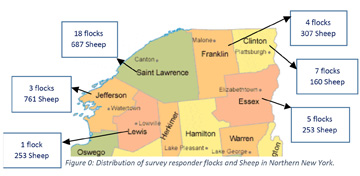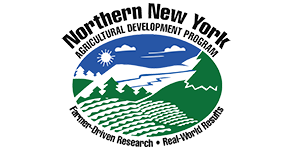
Canton, N.Y.; July 23, 2020. The Northern New York Agricultural Development Program has posted the results of the first surveillance for Johne’s disease in sheep on farms in northern New York at www.nnyagdev.org. The 2019 project report and a fact sheet prepared by Jessica Scillieri Smith, DVM, a New York State Department of Agriculture and Markets veterinarian, and Cornell Cooperative Extension Livestock Educator Betsy Hodge include tips for reducing the risk of this bacterial infection in sheep.
Johne’s disease impacts sheep, goats, and cows. It is a frequently misdiagnosed gastrointestinal disease in sheep; clinical signs of the disease can sometimes take years to appear. The disease can be asymptomatic, making it difficult to diagnose without widespread testing in sheep flocks. Testing can also result in false negative results.
“While there is significant research on Johne’s disease in dairy cattle, research into the prevalence and significance of this bacterial disease in smaller ruminants has been lacking. Funding from the Northern New York Agricultural Development Program has established a baseline survey of Johne’s disease in regional sheep flocks, and provided education to the participating farms,” said Dr. Scillieri Smith.
Thirty-eight farms representing a total of 2,421 sheep on farms in northern New York (NNY) participated in the baseline survey in 2019.
 Three hundred and nineteen two-year-old or older ewes from 13 flocks across Jefferson, Lewis and St. Lawrence counties and from eight flocks across Clinton, Essex and Franklin counties were selected for health surveillance sampling and Johne’s disease testing.
Three hundred and nineteen two-year-old or older ewes from 13 flocks across Jefferson, Lewis and St. Lawrence counties and from eight flocks across Clinton, Essex and Franklin counties were selected for health surveillance sampling and Johne’s disease testing.
Testing results showed Johne’s disease present in some NNY sheep flocks, however, the level of infection appeared low. It was present in more than 50 percent of the 21 tested flocks.
Smith and Hodge suggest the following tips to help protect sheep flocks from Johne’s disease:
- only buy sheep form flocks documented as known-negative for Johne’s disease,
- test animals of unknown status before bringing them into your flock,
- quarantine and test animals after purchase to address the risk of false negative test results,
- limit exposure of lambs to any known-positive adults in your flock,
- make sure food and water sources are difficult for animals to contaminate with manure which can carry Johne’s-causing bacteria, and
- talk with your farm veterinarian to develop a “best practices” plan with support from the New York State Sheep and Goat Health Assurance Program.
Lambs raised on pasture with their mothers can be at risk of infection from the bacteria in manure in pastures. Johne’s disease impacts farm economics in terms of animal mortality, decreased live lamb births, decreased fertility, fiber loss, and increased veterinary costs and labor.
Farms surveyed in the six-county NNY region reported a total of 5,356 sheep in the 2017 Census of Agriculture. Sheep are raised for meat, fiber, dairy, and breeding stock.
The researchers have recently been funded to assess the status of Johne’s disease in goat populations that may have a higher risk of the disease.
For more information, contact Betsy Hodge, Cornell Cooperative Extension of St. Lawrence County, 315-379-9192, bmf9@cornell.edu.
 Funding for the Northern New York Agricultural Development Program is supported by the New York State Legislature and administered by the New York State Department of Agriculture and Markets. Learn more at www.nnyagdev.org.
Funding for the Northern New York Agricultural Development Program is supported by the New York State Legislature and administered by the New York State Department of Agriculture and Markets. Learn more at www.nnyagdev.org.
CLICK HERE to see the American Agriculturist story on this project